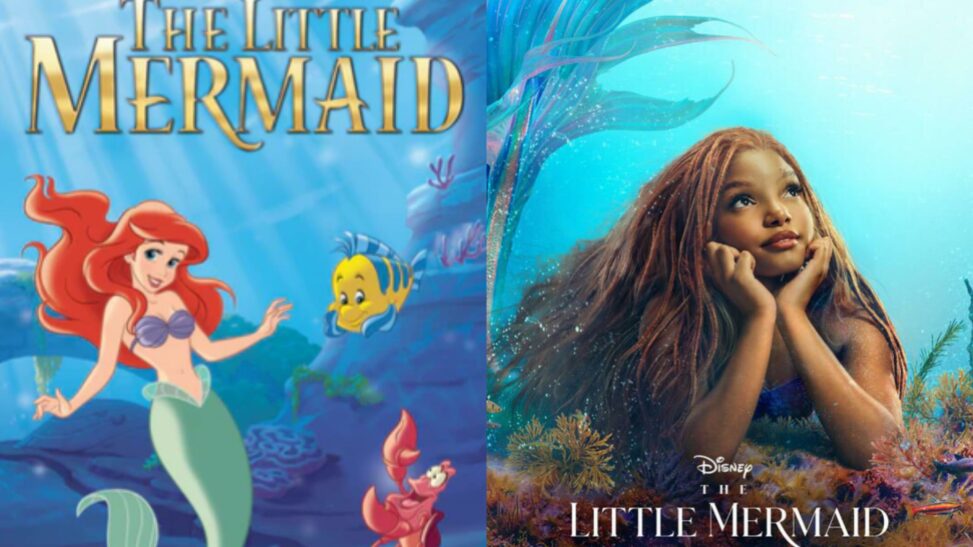Walt Disney Studios initially released The Little Mermaid in 1989 as an animated musical. The musical revolved around the life of 16-year-old Ariel, a mermaid who had always been fascinated with life on land. In 2023, Disney announced the release of a live-action remake of The Little Mermaid, but this time around, it came with a surprise for viewers: the young African-American artiste Halle Bailey would be playing the role of Ariel.
This elicited a mix of emotions amongst the audience, young and old alike. In the original 1989 animated film, the character was depicted as a white, red-haired character voiced by Jodi Benson, a White American actress, who was white. Instead of the norm, in the remake she is represented by a black woman adorned in locs which is notably different. “On September 10, 2022, Disney released its trailer for the new The Little Mermaid movie…and it was gorgeous. Days later, the web was alive with videos capturing gleeful responses of young Black girls as they watched the trailer and slowly recognized that the mermaid on screen looked like them.” (1) The representation of Ariel, a well-known and loved character by children all over the world with a black character was quite remarkable. Mermaids are fictional characters and the portrayal of such a character with a black woman and not the stereotypical white representation made black people around the world proud as they felt like they finally got some of the representation that was well needed in fictional characters.
Beyond just an animated character, Halle Bailey’s portrayal of Ariel in the live-action remake resonated with black people worldwide, that they could be represented in such ‘dreamy’ fictional characters as well. Initially, Walt Disney Studios released films like Cinderella, Beauty and the Beast, Snow White, etc., portraying protagonists as white characters upholding Eurocentric ideals. Disney for the first time introduced a black princess in their animated film ‘The Princess and The Frog’ in 2009, 72 years after their first animated feature film in 1937. However they hadn’t quite represented the black community in ‘dreamy’ ‘mythical’ characters like a mermaid, so this was huge. The original Little Mermaid represented the regular Disney stereotypical princess character which in contrast, the remake gave young black girls an opportunity to see themselves through the lens of Halle Bailey.
However, this came with its backlash from society, “Not so beautiful, but also not so surprising: the web was simultaneously polluted with racist diatribes about the need to #MakeMermaidsWhiteAgain” (2) The hashtag penetrated social media platforms like Twitter and Reddit, where people expressed their discontentment with Disney’s action to make Ariel portrayed by a black actress. Some argued Black mermaids lack mythological accuracy, while others insisted adaptations should remain true to the original version.(3)
The 2023 remake also deepens character narratives, contrasting the original 1989 version’s simpler storyline. “The 1989 version was unusual within the genre of film musicals for lacking what Rick Altman labels a ‘dual focus narrative’… In musicals, both the male and female leads are given equal scenes—often with comparable ‘I want’ songs.” (4) In the 2023 film, Prince Eric is given his own “I want” song, “Wild Uncharted Waters”, highlighting his ambition to explore other cultures, a trait he shares with Ariel. This narrative shift strengthens their bond beyond the typical “fairytale love story” and offers a richer portrayal of Ariel’s curiosity about the world. The remake shows that Ariel is a character who loves adventure which sets it apart from the 1989 version where she is presented as a character who is bored of aquatic life, we see in the remake that Ariel is a character who “does not dislike aquatic life but simply wishes to explore new cultures.” (5)
Ultimately, Bailey’s representation as Ariel is a step towards more representation for black people and other minority communities all around the world. “We can discern that the selection of Halle Bailey implies a significant step forward in terms of inclusion and equality in cinematic representation. Any individual, regardless of their background, can aspire to portray any character within the film industry.” (6) Through her portrayal, Bailey has provided Black viewers with a sense of belonging and pride, as they see a character who looks like them in a beloved story, this is with the hopes that more filmmakers will begin to involve elements of inclusion and diversity in production.
Endnotes
1. Jessica Pressman, “Hooked on Mermaids,” Minnesota Review 2023, no. 101 (November 1, 2023): 113–22, https://doi.org/10.1215/00265667-10770219.
2. ibid
3. Zalfa Melanie Putri, “Comparison in animated films The Little Mermaid (1989) and versions adaptation live-action The Little Mermaid (2023),” Syntax Idea 5, no. 7 (June 21, 2023), https://doi.org/10.46799/syntax-idea.v5i6.2374.
4. Niall Richardson, “Part of Whose World? How the Little Mermaid (2023) Attempts to Revise the Racist Tropes of the 1989 Animated Film Musical,” Alphaville: Journal of Film and Screen Media, no. 27 (July 2, 2024): 94–109, https://doi.org/10.33178/alpha.27.08.
5. ibid
6. Mónica Bonilla-del-Río and Arantxa Vizcaíno-Verdú, “‘The Little Mermaid Looks Like Me!’: Cross-Cultural Diversity, Inclusion and Children’s Self-Esteem on TikTok,” Psychology, Society & Education 15(3), 57–70. https://doi.org/10.21071/pse.v15i3.16098
Bibliography
Bonilla-del-Río, Mónica, and Arantxa Vizcaíno-Verdú. ““The Little Mermaid looks like me!”: cross-cultural diversity, inclusion and children’s self-esteem on TikTok.” Psychology, Society & Education 15(3), 57–70. https://doi.org/10.21071/pse.v15i3.16098
Pressman, Jessica. “Hooked on Mermaids.” Minnesota Review 2023, no. 101 (November 1, 2023): 113–22. https://doi.org/10.1215/00265667-10770219.
Putri, Zalfa Melanie. “Comparison in animated films The Little Mermaid (1989) and versions adaptation live-action The Little Mermaid (2023).” Syntax Idea 5, no. 7 (June 21, 2023). https://doi.org/10.46799/syntax-idea.v5i6.2374.
Richardson, Niall. “Part of Whose World? How the Little Mermaid (2023) Attempts to Revise the Racist Tropes of the 1989 Animated Film Musical.” Alphaville: journal of film and screen media, no. 27 (July 2, 2024): 94–109. https://doi.org/10.33178/alpha.27.08.


Emily
The Essay effectively described the similarities and difference between the 2 forms of Ariel Disney has portrayed. The comparison is detailed and emphasizes the appearance and race of the character. They Mention how the 1989 Ariel is a white, red-haired character voiced by Jodi Benson, while the 2023 Ariel, played by Halle Bailey, is a black woman with locs. This comparison is well illustrated with emotions responses from younger black girls seeing themselves represented on screen by a loved character. The Main points focus is the impact of Halle Baileys portrayal of ariel on representation for black communities. The essay also highlights the backlash from certain segments of society, noting the racist responses to the change. The essay incorporates a few scholarly sources and quotes to support its argument effectively. While the essay is comprehensive, it could delve deeper into the cultural and historical contact that influenced the portrayal of characters. The essay provides a thorough and insightful critique of the two depictions of Ariel, with a strong focus on the cultural impact of Halle Baileys portrayal. It is well organized and makes good use of scholarly sources, although there is room for improvement in integrating these sources more fluidly.